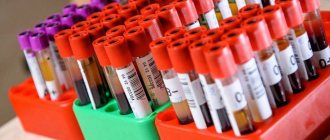Chlamydia is a disease included in the list of the most dangerous sexually transmitted infections. It is classified as a “new” disease, since chlamydia began to be identified only a few decades ago. The disease occurs hidden, but despite its apparent harmlessness, it causes enormous damage to health and affects the course of pregnancy and the health of the newborn if chlamydia is detected during pregnancy.
Appointment with a gynecologist, urologist – 1000 rubles. Consultation with a doctor based on the results of tests or ultrasound - 500 rubles.
If untimely or absent treatment, chlamydia causes complications. In women this is infertility, in men it is epididymitis (inflammatory process in the testes). Complications of chlamydia also include Reiter's syndrome, prostatitis, salpingitis, endometritis and many others.
What is chlamydia: causes and characteristics of infection
The content of the article
The frequency of infection with chlamydia is lower than that of gonorrhea, but, nevertheless, chlamydia is practically the most common sexually transmitted disease. Every year there are about 200 million new infections with chlamydia. Chlamydia is caused by the chlamydia bacteria - Chlamydia trachomatis.
Invading the body, chlamydia primarily affects the human genitourinary system and urogenital tract. In this case, chlamydia can occur as a single infection or in combination with other infections of the genitourinary system: trichomoniasis, bacterial vaginosis.
Chlamydia is a bacterium that penetrates inside a cell and uses its substances for nutrition and other aspects of life. This is an energy parasite that is unable to synthesize ATP on its own. Chlamydia reproduces by division, the microorganism has its own DNA and RNA. As a result, human mucosal cells die.
When chlamydia enters the body, it can successfully resist the immune system and live there for many years, but not harm the carrier until a certain point. At the same time, “dormant chlamydia” is still dangerous - an infected person acts as a carrier capable of infecting other people.
Now almost 1 billion people are carriers of chlamydia. As soon as circumstances change—for example, the immune system weakens—chlamydia immediately becomes more active.
The causative agent of the disease
Urogenital chlamydia is caused by bacteria of the species Chlamydia trachomatis. These are gram-negative intracellular organisms of a coccoid form, not capable of active movement. Scientists know 18 serotypes of this bacterium and several diseases associated with these microorganisms. Thus, various serological types of Chlamydia trachomatis can cause conjunctivitis, lymphogranuloma and genitourinary infections.
Chlamydia is known for its resistance to various adverse factors. These intracellular bacteria are able to transform into a protective form and hide for a long time from the action of the immune system. Also, the protective form of the bacterium helps to survive other negative effects, such as hypothermia or antibacterial therapy. When the bacteria become inactive, the symptoms of the infectious disease subside, causing many patients to stop treatment. In this case, a chronic course of the pathology often occurs.
Chlamydia trachomatis can only reproduce in host cells. The life activity of this microorganism is completely dependent on the energy resources of the affected cell, which is why chlamydia is called obligate parasites. Outside the cells, bacteria exist in the form of elementary bodies that spread like spores. The rigid cell wall of elementary bodies helps the parasite to hide from aggressive external factors.
How can you become infected with chlamydia: once is enough
The widespread distribution of the disease is explained by the fact that its symptoms are often not pronounced, and the patient may not be aware of the presence of chlamydia for a long time.
Sexual route: vaginal, anal and oral
! Chlamydia is a sexually transmitted disease and can therefore be contracted during unprotected vaginal or anal intercourse. There is a possibility of transmission of chlamydia through oral sex, which increases significantly in the presence of damage to the mucous membranes.
Is it possible to become infected with chlamydia if “it only happened once”? Clinical studies show that transmission of chlamydia occurs in 30-50% of cases of unprotected sexual contact, if sexual intercourse with an infected partner occurs no more than once. When chlamydia is detected in a person, it is imperative to check a regular sexual partner, since the risk of infection with regularly repeated sexual intercourse is almost 100%.
During childbirth
. There is a high risk of transmitting chlamydia from mother to child during childbirth, when the newborn passes through the birth canal. In this case, infection of the eyes and mouth occurs.
Household way
. In the external environment, the parasite can remain viable for 2 days, but it is sensitive to temperature conditions, surviving only at temperatures from 16 to 22 degrees. Therefore, there is a risk of household infection through dirty dishes, toilet seats, etc. is low, however, cases of infection through this route have also been observed. Including a small percentage of infections occurs due to the transmission of bacteria when visiting a bathhouse or sauna, since in the humid and cool environment of the dressing room, chlamydia feels “at home.”
Ways to get rid of chlamydia
The doctor prescribes treatment for patients only after the diagnosis has been accurately established.
This is due to the fact that the symptoms of STDs are very similar to each other.
Unfortunately, it is not possible to distinguish them without special diagnostics.
Patients are often interested in how to treat chlamydia trachomatis in women and men.
First of all, it is worth considering that you will have to use antibacterial drugs.
Because only they can destroy bacteria that have already entered the body.
Antibiotics of the fluoroquinolone, tetracycline, macrolide series, such as Azithromycin, Levofloxacin, etc., are suitable.
Doctors often prefer a course of two antibiotics, which can be supplemented with Metronidazole.
To increase the effectiveness of treatment, it is recommended to use drugs from the group of immunomodulators.
Their task is to strengthen the immune system and help it actively eliminate the infection.
For example, Polyoxidonium or Immunomax can be used as an immunomodulator.
After the acute process subsides, the doctor may add physical therapy to the treatment.
It will help the body recover faster and contribute to the normalization of functions lost due to illness, if they are not lost irretrievably.
Symptoms
The incubation period of infection ranges from – 1 week to – 2 months, during which time the infection spreads in the body. In 45% of men and 65% of women, the disease does not give any manifestations during this period and can only be detected through laboratory testing of biomaterials.
With acute chlamydia, men and women experience different symptoms. At the same time, the female body is more susceptible to infection - infection occurs faster and the consequences are more serious.
Immunomodulators
Treatment of chlamydia is complicated by the fact that during the period of illness the immune system is suppressed. Not all patients need to take immunomodulators, so it’s not worth injecting them on the basis of “it won’t get worse.”
For immunocorrection the following is prescribed:
- Immunomax – enhances protection against bacterial infections, injections in the first and last 3 days of the course;
- Erbisol – protects the liver from the toxic effects of antibiotics, 2 times for 20 days;
- Polyoxidonium – promotes comprehensive protection against infections, has detoxification properties, 10 injections every other day.
How does chlamydia manifest in women?
Manifestations of chlamydia in women at various stages of infection boil down to the following symptoms:
- Vaginal discharge. They have a mucous structure and may contain pus. May have an unpleasant, pungent odor.
- Pain appears during urination, a cutting or burning sensation.
- During menstruation, sharp pain in the genital area may occur.
- The appearance of bleeding between menstruation, the blood can be either pure or mixed with mucus.
- Low-grade fever, general weakness of the body, similar to the sensations during a cold.
Even one of the symptoms is an alarm bell, in which case you should definitely contact a gynecologist and get tested for chlamydia.
ethnoscience
There are so-called traditional methods of treating chlamydia:
- douching with garlic infusion;
- using garlic water tampons;
- drinking alcohol tincture with boron uterus;
- eliminating dairy products from the diet;
- starvation.
The effectiveness of these methods is controversial. For example, douching is considered harmful by many doctors, because it washes away all microflora and makes the mucous membrane defenseless against any pathogenic microorganisms. If you plan to try any of the above, be sure to consult your doctor.
How does chlamydia manifest in men?
In men, the manifestation of chlamydia is comparable to the symptoms of urethritis, and in the first stages, many do not pay attention to the problem, believing that everything is caused by inflammation after a cold or other “trifling” factors.
Chlamydia in men can cause the following symptoms:
- Transparent mucous discharge from the urethra.
- The presence of pus in the urine and its cloudiness.
- The color of the urine changes, and bloody discharge may appear, which may also be present in the seminal fluid during ejaculation.
- Urination is accompanied by a burning or stinging sensation.
- Spontaneous pain appears in the pelvic area, lower back, and scrotum.
- A low-grade fever is observed (the temperature rises from 37.1 to 38 degrees).
- General physical malaise.
It happens that chlamydia in men forms local colonies without general infection of the body. Focal accumulations without the development of an infectious disease are caused by strong immunity and antibody resistance to the effects of chlamydia. However, the man remains infectious.
What will happen if left untreated?
The consequences of chlamydia in men occur when the necessary therapy was not carried out, or if it was insufficient and ineffective, these are:
- Orchitis and orchiepididymitis. Chlamydia affects either the testicle or the testicle along with the epididymis.
- Reiter's syndrome. Simultaneous damage to the skin, joints and mucous membrane of the eyes.
- Funiculitis and vesiculitis. The spermatic cord and seminal vesicles are involved in the process of inflammation.
- Epididymitis. Inflammation of the epididymis. Characterized by high temperature and an increase in the volume of the appendage. The inflammatory process disrupts spermatogenesis and leads to infertility. Often occurs in parallel with orchitis (inflammation of the testicle).
- Urethritis with subsequent urethral strictures. The man will experience a frequent urge to urinate, and uncharacteristic discharge with pus and mucus will begin to appear from the urethra.
- Prostatitis. Against the background of chlamydia, the prostate gland becomes inflamed, urination is difficult, pain in the groin and lower back, and watery discharge appear. The prostate becomes sensitive to touch, painful, heterogeneous structure.
In addition to these numerous inflammations of the genitourinary system, chlamydia can affect other organs. With an ascending infection, the pathological process may involve the kidneys, peritoneum, and liver. Therefore, high-quality diagnosis of the disease and its timely treatment are so important.
Oral chlamydia and its symptoms
When infected with chlamydia during oral sex or when transmitting bacteria through household means through dishes, etc. Oral chlamydia develops, affecting the oral cavity, throat, and nasopharynx. In this case, the following symptoms of the disease may be observed:
- Constant bad breath.
- The nasopharynx becomes covered with mucous deposits.
- Gradually, the mucus moves to the upper palate and tongue.
- There is nasal congestion and difficulty breathing.
- Enlarged tonsils, swelling of the back of the throat.
- Loss of taste due to mucus on the taste buds of the tongue.
- Pain when pressing on the mucous membrane of the throat, palate or tongue.
- Difficulty breathing due to a swollen throat.
- Attacks of suffocation most often occur in the evening or during hot periods.
Over time, the patient loses taste sensitivity, and eating is accompanied by pain that appears when food passes through the sore throat. A constant unpleasant sensation in the mouth develops. Spasmodic, involuntary twitching of the tongue is acceptable.
Since the symptoms of chlamydia are quite vague and often resemble manifestations of other diseases, it is necessary to consult a doctor in case of any abnormalities (discharge, itching, burning). For women it is a gynecologist, for men it is a urologist.
Organs that can be affected by chlamydial infection
Chlamydia can attach only to certain tissue: columnar or cuboidal epithelial cells. It is found only in some organs - in the urethra, cervical canal, fallopian tubes, lower rectum, conjunctiva of the eye, bronchi. Therefore, although the infection primarily affects the genitourinary system, chlamydia is also dangerous for other organs: the cardiovascular system, lungs, joints, gastrointestinal tract, kidneys, organs of vision and hearing. In women, even asymptomatic chlamydia can cause inflammation of the pelvic organs: uterus, ovaries, fallopian tubes. With prolonged inflammation due to the adhesive process, the fallopian tubes can become blocked, which prevents eggs from reaching the uterus and infertility develops. In approximately half of cases of infertility in women, chlamydia is to blame.
Complications
Chlamydia often causes serious illnesses, which are a complication of the disease if treatment is improper or ineffective. In particular, the following consequences were identified:
- Reiter's syndrome
is the most serious complication, during which symptoms of urethritis, conjunctivitis and arthritis develop. In the final stages, joint deformation occurs - the cause of disability for life. - Orchiepididymitis
- a disease fraught with male infertility due to the destruction of Leydig cells, which contribute to the spermogenesis procedure. - Urethral stricture
- due to the appearance of scars on the tissue caused by the attack of chlamydia, the urethra narrows and is pinched, resulting in sharp pain when urinating. To correct the situation, surgical intervention is performed. - Chronic prostatitis
- chlamydia has a complex negative effect on the prostate, promotes narrowing of the ducts, reduces the production of prostate secretions, lowers the level of testosterone production, which leads to a decrease in potency.
The complications described above appear in the stages of advanced chlamydia if treatment is not started on time. In most cases, complications can be avoided.
Pathophysiology
The pathophysiological mechanisms of chlamydia are not well understood. Due to the fact that the bacteria specifically attack columnar epithelial cells, young women are most vulnerable to the disease. This risk factor can be explained by the histological features of the structure of the cervix. The body's initial response to invasion is the active recruitment of neutrophils. The site of infection then also receives other components of the immune system, including lymphocytes, macrophages, plasma cells, and eosinophils. Affected cells release cytokines and interferons, which triggers inflammatory processes in tissues.
Infection of the body with chlamydia provokes a response from the humoral immune system, which leads to the active release of immunoglobulins IgA, IgM and IgG. The source of the immunological response is the proteins of the outer membrane of the bacterium. Chlamydia itself has a two-phase life cycle, allowing them to perfectly adapt to the intracellular and external environment. In the extracellular environment, so-called elementary bodies are found, which are metabolically inactive infectious particles. As soon as the bodies are inside the cell, mechanisms of protection against the immune response and reorganization of the bacterium into a reticular (active) form are activated.
Reticular forms of bacteria synthesize their own DNA, RNA and proteins, which requires energy from the host cell in the form of adenosine triphosphate (ATP). After the formation of a sufficient number of reticular components, some microorganisms are again transformed into elementary particles and leave the cell for further spread. The average incubation period varies from 2 to 3 weeks.
Get tested for chlamydia
Chlamydia during pregnancy
Chlamydia has a serious impact on the course of pregnancy and can cause a wide range of problems and malfunctions in the female body. Depending on at what stage of pregnancy chlamydia began, you may encounter the following consequences:
- Blastopathy – the death of the fertilized egg occurs, which ends in a frozen pregnancy or miscarriage.
- Embryopathy – abnormalities in the development of the fallopian tubes;
- Premature birth.
- Ectopic pregnancy.
If chlamydia was suffered before pregnancy, it can cause failure of nidation of the fertilized egg, which in the vast majority of cases leads to female infertility. Taking into account all the risks, testing for chlamydia is mandatory when planning pregnancy, as well as at various stages of bearing a child, if signs and symptoms of the presence of chlamydia in the body appear.
Even if chlamydia did not cause significant problems during pregnancy, chlamydia can be passed on to the baby during childbirth. The most serious complication in newborns resulting from maternal chlamydia is neonatal chlamydial pneumonia. This disease is difficult to treat, has many complications and high mortality statistics. Children born to a mother with chlamydia must be tested for infection between 1 and 3 months of age.
Difficulties in treating chlamydial urethritis
The content of the article
Due to the frequent coexistence of chlamydial urethritis with other sexually transmitted diseases, especially gonorrhea, and also due to the mild or even asymptomatic course of the infection, its treatment remains a big problem.
Additional difficulties in determining the appropriate dose and duration of treatment with an appropriately selected antibiotic are created by the cycle of intracellular development of chlamydia with the presence of infectious elementary and non-infectious reticular bodies and the possibility of their survival in the submucosal tissue.
How is chlamydia diagnosed: tests for chlamydia
To date, several effective methods for diagnosing chlamydia have been developed, which make it possible to determine the presence of an infectious pathogen even if it is present in the sample in minimal quantities. A smear, scraping from the surface of the genital organs, blood, seminal fluid, etc. can be used as the test material. Diana Medical Center does not use rapid tests to diagnose chlamydia, which provide false results.
Basic and most highly effective techniques.
- Immunofluorescence reaction (RIF);
- Enzyme-linked immunosorbent assay (ELISA);
- Polymerase chain reaction (PCR);
- Culture for chlamydia.
General smear (the probability of detecting the presence of chlamydia in this way is no more than 15%, so the use of this analysis is not effective, but it will help to identify concomitant infections that aggravate the problem). Read about tests for chlamydia here.
Striving for maximum accuracy and information content, preference is given to high-tech methods:
Enzyme-linked immunosorbent test (ELISA)
The technique makes it possible to fairly accurately determine the stage of the disease and chlamydial origin, as well as the presence of microorganisms in other organs not related to the genitourinary system. It has a relatively high research accuracy - up to 60%. It can be effectively carried out only after the development of specific antibodies to chlamydia has begun - 5-20 days from the moment of infection.
This is due to the fact that ELISA and RIF - enzyme-linked immunosorbent assay and immunofluorescence reaction research are not aimed at identifying the causative agent of chlamydia itself, but at detecting specific antibodies to this particular antigen. This is achieved through the controlled formation of antigen-antibody complexes, which in the case of the RIF method are labeled with a fluorescent substance, which makes the resulting complexes luminous. This makes them easier to detect during microscopic examination of the material.
During the research, the concentration of antibodies of the IgM, IgA, IgG groups produced by the body during protection against chlamydial infection at different stages of infection of the body is determined. The research takes quite a bit of time and is inexpensive.
Polymerase chain reaction (PCR)
The PCR method is highly effective and allows us to say with 100% probability whether there is chlamydia in the body or not. The study is based on the technology of detecting chlamydia DNA in a sample taken - scraping from the urethra, prostate secretion, ejaculate, urine sediment, saliva, blood and other biomaterials. Determining the results, depending on the equipment used, takes up to 3 days.
By triggering the reaction of duplicating DNA segments, a specialist can, in a short period of time, obtain the genetic chain of an infectious pathogen that is a million times longer in comparison with the primary segment. This allows chlamydia to be identified with 100% accuracy.
The technique is highly accurate; obtaining incorrect results is only possible if the sampling technology or transportation of the biomaterial is violated.
Chlamydia culture
Microbiological testing is 90% accurate in identifying chlamydia in the body.
By inoculating a sample of biological material on a special nutrient medium and creating favorable conditions for reproduction and growth, after some time it is possible to obtain a full-fledged colony of the pathogen. In this case, it is not difficult to identify the infection by simple microscopic examination. The advantage of this technique is the possibility of testing the sensitivity of the pathogen to various antibiotics. This allows you to choose the most effective drug for the treatment of chlamydia.
Preparation for testing for chlamydia trachomatis
Preparation for analysis largely depends on what material and where it will be taken from in order to perform the diagnosis.
If you plan to do an ELISA, a blood test will be taken from a vein from the patient.
The procedure is standard and does not present any difficulties.
The recommendations are simple:
- do not eat food before taking the test,
- visit the clinic to collect material in the morning,
- stop taking alcohol and antibiotics a few days before the test.
A smear from the urethra in both women and men usually requires more careful preparation.
It is necessary to refrain from sexual intercourse and the use of hygiene products for treating the genitals.
You will also have to avoid urinating for at least 3-4 hours.
Since a smear from the urethra is a painful procedure for men, they can replace this method of obtaining biological material with collecting sperm or urine.
It is also possible to detect chlamydia in both biological fluids.
Treatment of chlamydia
Since the causative agent of chlamydia is an intracellular bacterium, antibacterial drugs are used in the treatment of the disease (etiotropic therapy). Antibiotics are selected that destroy microorganisms of the identified group. Only a competent specialist can prescribe suitable medications based on the tests performed and after identifying the type of chlamydial bacteria, the affected area and the progress of the disease.
In addition, if there are concomitant infections, antibiotics, antifungals, and immunomodulators can be used. If there is a large amount of discharge, antimicrobial agents will be required.
As a rule, drugs are prescribed in the form of tablets, injections, and can be used locally in the form of vaginal suppositories for women. In most cases, several medications and auxiliary agents are combined, which also reduce the possibility of developing complications or intoxication of the body. Treatment is carried out at home. After completing the course of therapy, after 2-3 weeks a repeat test for chlamydia is done and if no bacteria are found, the treatment can be considered successful.
An important nuance is the need to notify the sexual partner about the presence of chlamydial infection, since with a high probability the partner may be infected with chlamydia, which will also require treatment using the same drugs and techniques. Doctors recommend that both partners be tested at the same time and treated together. This will avoid secondary infection.
Why is it necessary to promptly treat urological infections such as STIs?
In the study, Patton studied microbial treatment and the ability to reduce inflammation in the fallopian tubes of chlamydia-infected macaques in vitro, using doxycycline in combination with ibuprofen or triamcinolone. The addition of anti-inflammatory drugs had little effect on reducing inflammation in organs affected by chlamydial infection in animals.
These results indicate that it is necessary to begin treatment with appropriate antibiotics as early as possible to avoid scarring and fibrosis in the fallopian tubes. Early treatment is also very important because of the observed lower effectiveness of antibiotics for chronic chlamydia infections.
Scarring in the fallopian tubes
Urologists believe that this fact may be associated with a decrease in the content of MOMP, the main outer membrane protein contained in the outer membrane of the elementary bodies of Chlamydia trachomatis during prolonged infection. This phenomenon may interfere with the transport of antibiotics to chlamydia cells, although this process is not fully understood.
In the treatment of urogenital infections caused by Chlamydia trachomatis, a high relapse rate remains a serious problem. Uch. Batteiger and colleagues showed that relapses occurred in 26% of their patients within 3 years. Also the team of uch. Blythe estimated the relapse rate in a group of young women to be 39% over a two-year follow-up period. These data indicate the need for in-depth examination and treatment of patients and their sexual partners.
Double control after the end of treatment would be correct. The first is after 1-2 weeks to ensure that the patient and his partner have received appropriate treatment, the second after 4-6 weeks to detect possible re-infection.
It has been observed that the incidence of Ch.t. it is growing, especially in developed societies. Proper management of the patient and his sexual partner, as well as the selection of an appropriate chemotherapy agent, are the most important elements of therapeutic treatment aimed at reducing the incidence of genitourinary tract infections caused by Chlamydia trachomatis.
Prevention of chlamydia
To reduce the risk of chlamydia and the development of chlamydia, it is recommended to adhere to simple rules of personal and intimate hygiene, as well as caution in choosing sexual relations. Protect against chlamydia:
- Using a condom during sexual intercourse.
- Refusal of casual relationships in favor of one permanent partner.
- Compliance with the rules of personal intimate hygiene, especially after visiting public baths and saunas.
It is recommended to be tested annually for chlamydia and other sexually transmitted infections (STIs, STDs) and non-sexually transmitted infections. It is also mandatory to take the test when planning a pregnancy and repeat it during pregnancy.
The use of contraception and compliance with moral standards when engaging in sexual activity will significantly reduce the risk of infection with chlamydia and the subsequent development of chlamydia in men and women.
Antibiotics
The main role in the treatment of chlamydia is given to antibiotics. Represented by 3 pharmacological groups: tetracyclines, macrolides, fluoroquinolones.
Tetracyclines
Contraindicated during pregnancy and lactation; not prescribed to children under 14 years of age. Doxycycline, Unidox Solutab and Vibramycin are indicated for uncomplicated forms of infection (urethritis, cervicitis). Doxycycline is taken only twice a day, but causes nausea and vomiting in many patients.
Macrolides
The group is represented by a wide range of drugs that are highly effective (97%) against mixed infections (mycoplasma, gonococcus, Treponema pallidum) and are safer than tetracyclines. These include:
- Erythromycin – has increased biological activity, but causes digestive upset (2 times a day for 10 days);
- Rovamycin – has low toxicity (3 times a day for 10 days);
- Sumamed - used for combined infections (chlamydia + syphilis or gonorrhea), a “loading” dose (1000 mg) is taken on the first day, in the next 5-7 days 500 mg;
- Rulid – inhibits chlamydia and ureaplasma, taken 2 times a day for 14 days;
- Klacid - used for long-term ureaplasmosis and chlamydia, it can be administered intravenously (2 days), then orally (10-12 days).
Fluoroquinolones
They are prescribed less frequently than those listed above, as they have increased toxicity. Ofloxacin, Tsiprolet, Abaktal are used for the treatment of combined, chronic infections: chlamydia, gonococcus, gardnerella, mycoplasma.
Why you can’t use folk remedies for chlamydia
Today, there is a widespread fashion in the world for folk remedies.
People mistakenly believe that with the help of various herbal recipes, any disease can be cured with fewer side effects.
Unfortunately, this is not the case, and chlamydia is a great example of this.
Herbs, suppositories based on natural ingredients and other similar products cannot help in the fight against pathogenic microorganisms.
This must be remembered once and for all.
Folk remedies do not have sufficient pharmaceutical activity to destroy pathogenic microorganisms.
They will simply slow down their reproduction or transform the infection into a chronic latent form.
One of the most common reasons for treatment failure is precisely the fact that patients try to be treated using folk remedies.
Frankly disregarding the recommendations given to them by the attending physician.
As a result, the disease constantly recurs, each time causing more and more significant damage to the already weakened immunity.
The symptoms of the disease also become brighter with each relapse.










